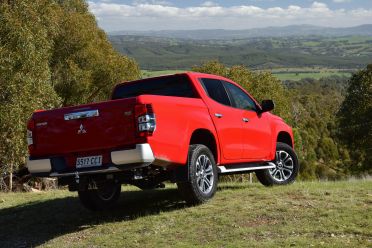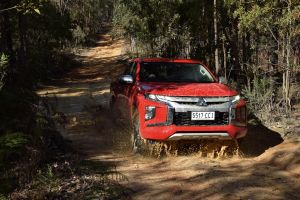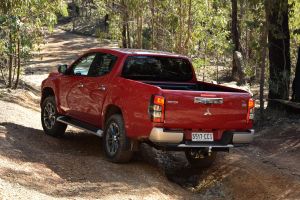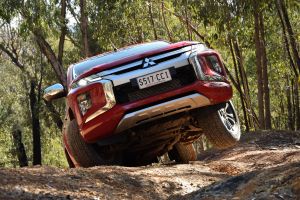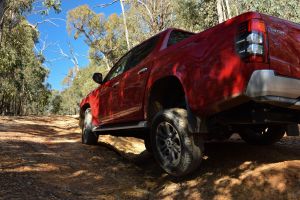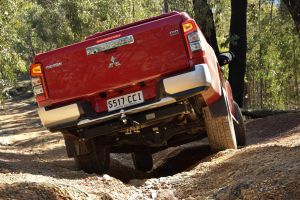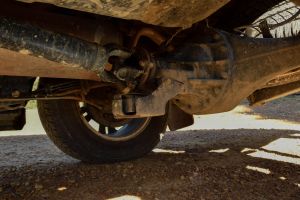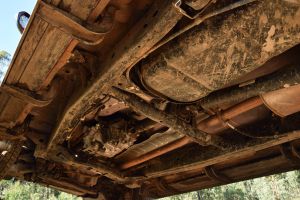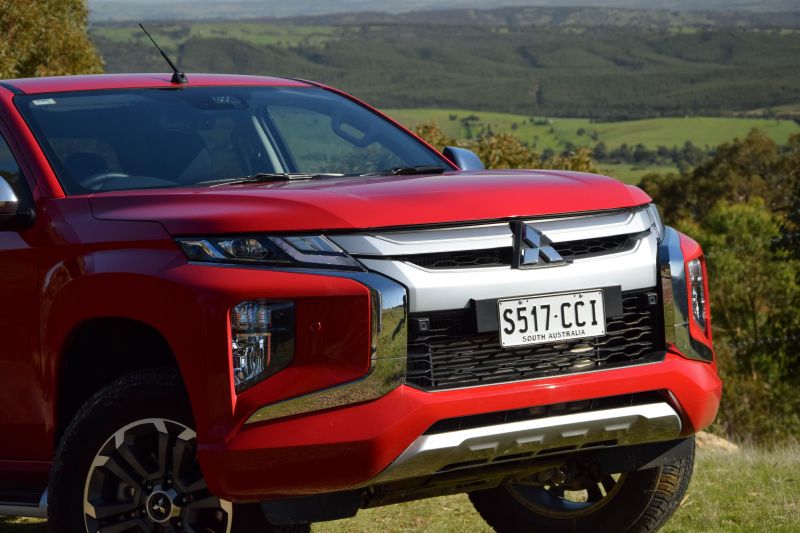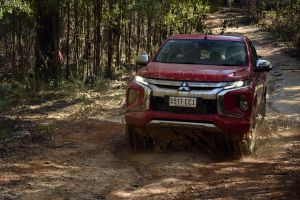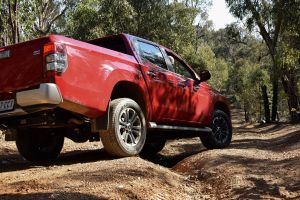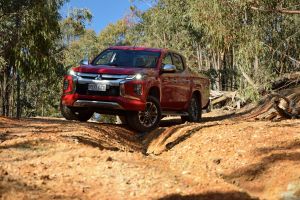Sneaking into the top ten vehicle sales in Australia and the third top-selling 4×4 is the unassuming Mitsubishi Triton. Whilst I’d love to say it is often overlooked, sales figures prove otherwise.
The Triton has been a stable mover for Mitsubishi over the years and the recent facelift and upgrades will ensure it stays there. If that sounds like a glowing introduction, let’s put rubber to dirt and see how the latest Triton actually performs off-road.
The initial leg of any off-road trip is getting out of town and making some headway on the highway. I found the Mitsubishi Triton GLS we had on test noisy, tinny and clunky around town and over speed humps.
At slow city speeds it presents as rather primitive in layout, performance and handling. The transmission takes a while to warm up, but by the time you hit the highway the Triton is surprisingly pleasant to drive with reduced wind and road noise, as well as performance and handling that are more akin to Mitsubishi’s top-end reputation.
It’s also worth noting here that the current facelifted model is the best-presented Mitsubishi Triton I have seen, with a muscular, bold and rugged new look that celebrates the design evolution of earlier models and breaks new ground with its beefier looking front.
Whilst the look has nothing at all to do with off-road performance, it’s my opinion that the look of an off-road vehicle plays an important role in its overall appeal. But does it have the credibility to back it up?
How does the Mitsubishi Triton GLS perform off-road?
Hitting the dirt it’s apparent that the ride and handling of the Triton are quite positive for an independent front suspension-equipped dual-cab mid-size 4×4.
In both ‘2H’ and ‘4H’ modes the ride is smooth, corrugations are dealt with sufficiently and the vehicle holds the road well. It’s around here that you start to get an appreciation for two of the key positives with this vehicle.
First is the 4×4 activation system. It’s modern, easy to reach and there’s no excessive back and forth or bumping around to engage and disengage each setting. It’s based on the highly-regarded Super Select system in the mechanically-related Pajero Sport and it’s a breeze to understand and use.
It also offers a unique safety and performance feature within the dual-cab utility market which enables this model to be driven on road in AWD mode (4×4 with the centre differential unlocked).
Along those lines, the in-dash LED indicators (found centrally within the instrument cluster) for 4×4 selection are excellent. They are clear, provide instant information on what setting is selected and even provide prompts to assist with engagement.
The second positive is the amazingly tight turning circle. The term nimble jumps to mind as you work your way up and down 4×4 tracks.
It’s not just the steering though, the wheelbase and wheel track all combine to provide an agile vehicle that is very well-suited to Australia’s typical 4×4 tracks – and it’s around here that the Triton really starts to excel.
As we drop down to ‘L4’ and hit the harder stuff, the Triton crawls along with an air of ease and precision (the new transfer case has a lower reduction ratio of 2.56:1).
The traction control works fine but again the real deciding factor we see across this independent front suspension sector is the rear differential lock, and this model fortunately had one fitted.
With the diff lock engaged the Triton felt unstoppable. It cut its way across ruts, over humps and up and down steep sections with finesse.
Even in the more challenging sections where the suspension limits were exceeded and tyres left terra firma, the Triton remained poised under pressure and well in control. In fact it was surprisingly pleasant under expectedly unpleasant conditions.
One point though is that activating the rear diff lock deactivates the traction control. Some competitors, like the Ford Ranger and Mazda BT-50 have thought this through and allow the traction control across the front axles to operate.
Is it an oversight by Mitsubishi or an indication of the limitations of its traction control system, or the capability of the Super Select 4×4 system? That is yet to be answered but it’s clear that such an oversight really doesn’t have a huge effect on its off-road performance.
Out the back the pros and cons are much like the Triton itself: understated, yet clearly there.
Starting with the negatives, the bulky tow bar mounts eat into the departure angle considerably and a forward-facing and low-slung harmonic balancer on the differential is a likely ‘hang up’ point off-road and is odds on to be ripped off completely in basic off-road situations.
In terms of pros, the vehicle comes standard with a tub liner. Basic as it may be, it’s fit for purpose with well placed tie-down points. Adjustable tie-down points would be nice but for price versus functionality, it’s a balance most users will happily live with.
Reactive off-road features also offered included hill-descent control and four driving modes branded as sand, mud and snow, gravel and rock crawling.
What’s under the bonnet?
The 2.4-litre direct-injection four-cylinder turbo-diesel remains the same (133kW/430Nm), but a newer six-speed automatic refines drivability and power delivery compared to the previous five-speeder. The downside though is an increase in fuel usage from 7.6L/100km to 8.6L/100km.
Our test showed an average consumption of 9.6L/100km, which is not surprising for your average journo. With that said, and from a driver’s perspective I would be happy with the increase for the sake of the improved drivability.
Another pro for the Triton is its engine braking. The manual select is smooth and easy to use whilst the compression-applied braking really works well on steep descents, especially at speed in steep alpine regions.
This is a real bonus for safety, control, and minimising excessive brake use – the possibility of brake fade is very common in 4x4s on long steep mountain roads.
You may be initially disappointed with the maximum tow rating of 3100kg, compared to many others in the class offering 3500kg, but it may well be a more appropriate figure when rivals are possibly inflated and could experience chassis and suspension issues at higher loads.
It’s not the best tow vehicle in its class but the rating is a solid guide to what the vehicle can actually handle. Again, this fits with the theme of the Triton being unassuming yet reliable, and fit for purpose.
Can you modify the Mitsubishi Triton GLS?
As a popular and long-standing 4×4, and its ability to share parts with the Pajero Sport, there’s no shortage of parts, accessories, information, and mods to amplify the Triton’s on- and off-road performance.
With plenty of bar work, protection equipment, roof racks, suspension and more available, customising and improving the Triton’s already solid base is a snap.
CarExpert’s take on the Mitsubishi Triton GLS
For an experienced off-road driver, the Triton is actually a pleasure to drive in tougher conditions. The exterior is rugged and appealing, the interior and city driving experience is best described as rudimentary and fundamental, yet it’s these simple characteristics that make it practical, comfortable and capable off-road.
Off-road is where this little nugget really shines. The Triton does the basics around town, lifts its game slightly on the highway and performs solidly in the tougher stuff.
It’s no wonder why the Triton is a consistent seller for Mitsubishi, while the new look and performance, teamed with the sharp pricing (there is a small price hike but rumour has it that dealers are well practiced in discounting), will only improve that standing.
I give the new Triton the thumbs up. It is what it is, it doesn’t try to be any thing more. Purchased as is, it meets expectations as a basic spec dual-purpose 4×4 vehicle.
If you want a vehicle that can do what a Ranger and HiLux will, but not come with the price tag (and are happy to settle for a number of lower-spec features), the Triton GLS should definitely be on your shortlist.






